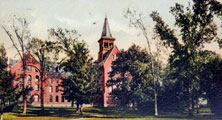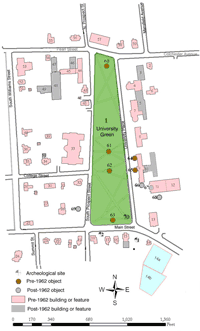 |
University Green Area Heritage StudyHistoric Burlington Research Project - HP 206Historic Preservation Program - University of Vermont |
86 South Williams Street
(Booth House)
(Photo taken by Julie Senk)
Situated
at 86 South Williams Street lies a two-story Colonial Revival structure known
as the Booth House. The building was built circa 1900.1 and
for a time found itself as the residence of various University of Vermont
professors. Professor Arthur D. Butterfield was the first occupant of the
house, moving in with his wife in 1900.2 Butterfield
was an Assistant Professor of Mathematics at the time3 and would go on to become the Chairman of the Mathematics Department, retiring
several years later in 1944.4 His time at 86 South Williams Street was short- lived: by 1903 the
brand-new structure lay vacant.5 Carlton B. Stetson, who was a Professor Pro Tempore of Greek at
86
South Williams Street would soon come to be known as the Booth House, named
after its longest occupant, John E. Booth. Booth’s father, Edward J. Booth,
acquired the land and house from then deed-holder, Albert E. Richardson, in
191312 and sold it to his son, John, in 1915.13 The following year, John E. Booth, along with his wife Muriel Badger, moved
into the house on 86 South Williams Street14 that would serve as there home for the next fifty-plus years.
John
E. Booth (photo on left, courtesy of UVM Special Collections) was the nephew of
J. R. Booth, a multi-millionaire who made his fortune by running one of the
most prominent lumber corporations in Canada, the John R. Booth Lumber Company,
with many branches located throughout the United States.15 After graduating from Burlington High School and attending Dartmouth College
for one year, John E. Booth began work as a “tally boy” in 1908 at his uncle’s
Burlington, Vermont lumber firm.16 By
the time Booth moved into 86 South Williams Street he was traveling throughout
Northern New England as the firm’s sales manager.17 In 1920, Booth was promoted to assistant manager underneath his father,18 Edward J. Booth, who managed the firm at the time.19 Booth eventually purchased the Burlington, VT, agency of his uncle’s lumber
firm in 1925, renaming it the John E. Booth Lumber Corporation.20
Although Booth’s occupation had
him traveling often, it did not stop him from renovating and expanding his home
on 86 South Williams Street over the years. By 1926, Booth had added a front
porch that travels the full length of the front facade21 and had alterations done to the main entrance-way door and its surroundings
(photo below, courtesy of UVM Special Collections).22 The
south side of the house was expanded during this time as well.23 It was also during this period that Booth oversaw the construction of a
one-room car garage situated in the rear of the lot, as it appears on a Sanborn
Insurance map after 1919 and before 1926.24
Booth
commissioned other alterations and additions to his home over the years,
including renovations to bathrooms25 and the construction of a pergola in 1937.26 Maps of the property also show that a porte-cochere was built after 1926 and
before 1942, as well.27
By
1944, Muriel B. Booth and John E. Booth were the only occupants of the home up
until their deaths in 1966 and 1969, respectively. The University of Vermont
purchased the building from the estate of John E. Booth in 1970.29
Extensive renovations were done to the Booth House following its
purchase by the University in the mid 1970s so that it could function
more efficiently as office space. These renovations included wall-to-wall
carpeting, the painting of walls, new furnishings, etc.30 The building also went through a series of inspections to ensure that it was up
to code.31 However, several interesting features
have been preserved inside the house despite these renovations, including the
original bathrooms on the second and third floor, both of which display antique
fixtures and tiles.
Since
then, the Booth House has served as the University of Vermont Alumni House, the
Development Office, and now functions as the Communications Office.
Notes
1
Burlington Free Press, June 8, 1928.
2
Burlington City Directory, (Burlington,
VT: L.P. Waite and Co. Publishers, 1901), 86.
3
Ariel, (St. Albans: VT: Press of
Cummings Printing Company, 1902), 20.
4
David J. Blow, Historic Guide to Burlington Neighborhoods, (Burlington,
VT: Chittenden County Historical
Society,
1991), 114.
5
Burlington City Directory, (Burlington, VT:
L.P. Waite and Co. Publishers, 1903), 314.
6
Ariel, (Burlington, VT: Free Press
Association Printers, Binders, and Stationers, 1904), 17.
7
Burlington City Directory, (Burlington,
VT: L.P. Waite and Co. Publishers, 1905), 253.
8
Burlington City Directory, (Burlington,
VT: L.P. Waite and Co. Publishers, 1908), 70.
9
Burlington City Directory, (Burlington,
VT: L.P. Waite and Co. Publishers, 1911), 67.
10
Burlington City Directory, (Burlington,
VT: L.P. Waite and Co. Publishers, 1912), 203.
11
Ariel, (Rutand,
VT: The Tuttle Company Printers and Binders, 1913), 29.
12
Burlington, VT, Warranty Deed, compiled by M. Grandy, City Clerk, Received for record June 21, 1913,
Book 65, Page 81.
13
Finalized sale between E. J. Booth and
John E. Booth in 1920:
State of Vermont,
Chittenden County, Warranty Deed, compiled by Edward B. Cooley, City Clerk,
Received for record July
3, 1920, Book 76, Page 258.
14
Burlington City Directory, (Springfield, MA: H.A. Manning Co., 1916), 80.
15
Burlington Daily News, May 7, 1925.
16
“Booth Succeeds Booth,” Reprinted from
the Lumbermanʼs Review, June 1925.
17
Burlington Daily News, May 7, 1925.
18
Burlington City Directory, (Springfield, MA: H.A. Manning Co., 1920), 100.
19
Burlington Daily News, May 7, 1925.
20
“Booth Succeeds Booth,” Reprinted from
the Lumbermanʼs Review, June 1925.
21
"Burlington, Vermont, 1926," Sanborn Fire Insurance Map, New York: Sanborn Insurance Map
Company,
1926.
22
“Additions and Alterations to the
Residence of J. E. Booth,” Louis S. Newton Papers, University of
Vermont
Special Collections, 1926.
23
"Burlington, Vermont, 1926," Sanborn Fire Insurance Map, New York: Sanborn Insurance Map
Company,1926.
24
Ibid.
25
“Alterations and Additions to the
Residence of J. E. Booth,” Louis S. Newton Papers, University of
Vermont
Special Collections, 1937.
26
John E. Booth to L. S. Newton, April 21,
1937, Louis S.
Newton Papers, University of Vermont Special
Collections
27
"Burlington, Vermont, 1926," Sanborn Fire Insurance Map, New York: Sanborn Insurance Map
Company,
1926.
28
Burlington City Directory, (Springfield, MA: H.A. Manning Co., 1933-43).
29
Burlington, Vt, Vermont Administratorʼs Deed, Received for record February
13, 1970, Book 65, Page
722.
30
Booth Building Files, University of
Vermont Special Collections, 1975.
31
Ibid.
|



